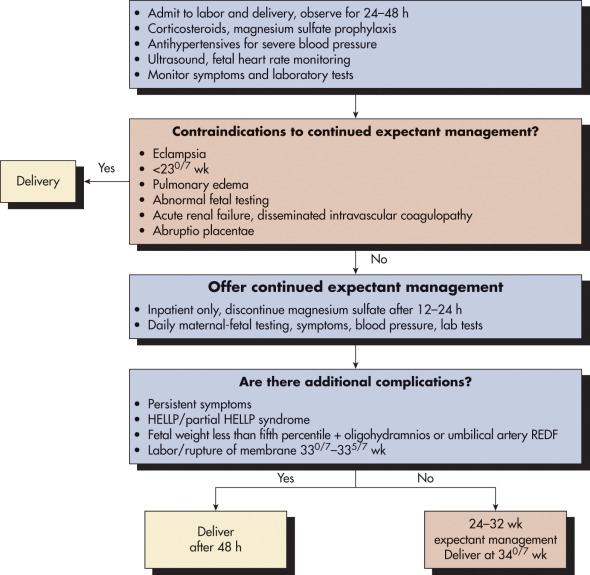Author: Bethany K. Sederdahl, MPH, MD and Philip A. Shlossman, MD
Hypertensive disorders of pregnancy represent a spectrum of disease ranging from gestational hypertension to severe preeclampsia. Preeclampsia is defined as new-onset hypertension (systolic blood pressure ≥140 or diastolic ≥90) after 20 wk gestation or up to 6 wk postpartum in the presence of proteinuria or evidence of end-organ injury.1 In the absence of proteinuria, other criteria, including thrombocytopenia, acute kidney injury, impaired liver function, pulmonary edema, and new-onset neurologic symptoms, can be used for diagnosis. In 2013, the American College of Obstetricians and Gynecologists (ACOG) Task Force on Hypertension in Pregnancy revised the criteria, making the presence of proteinuria unnecessary to make the diagnosis.2 The task force reinforced the importance of hypertension as a necessary condition and deemphasized proteinuria.
Hypertensive disorders of pregnancy can be categorized as follows:1
- Gestational hypertension: Hypertension in pregnancy after 20 wk without proteinuria or evidence of end-organ injury
- Preeclampsia: Hypertension in pregnancy after 20 wk, with proteinuria but without evidence of end-organ injury
- Preeclampsia with severe features (Table 1)
- Chronic hypertension: Hypertension pre-dating pregnancy or present at <20 wk gestation
- Chronic hypertension with superimposed preeclampsia: The presence of chronic hypertension with elevation in blood pressure from baseline often requiring increasing antihypertensives or with development of new onset of signs or symptoms meeting criteria for severe preeclampsia (Table 1)
- Hemolysis, elevated liver enzymes, and low platelet count (HELLP) syndrome: A severe form of preeclampsia defined by lactate dehydrogenase (LDH) greater than 600 IU/L, liver enzymes (aspartate aminotransferase [AST], alanine transaminase [ALT]) greater than twice the upper limit of normal, and a platelet count less than 100 × 109/L
TABLE 1 Criteria for the Diagnosis of Preeclampsia with Severe Features
|
- Pregnancy-induced hypertension (PIH)
- Hypertensive disorders of pregnancy (HDP)
- Severe gestational hypertension
| ||||||||||||||||||||||||||||||||||||||||||||||||||||||||
Hypertensive disorders of pregnancy are recognized as the second leading cause of maternal mortality (after hemorrhage) and are attributed to 18% of maternal mortality globally. The global incidence of preeclampsia is estimated to be 2% to 4% with significant regional variation.3,4 The disease burden is borne disproportionately by women in low- and middle-income countries or who are otherwise disadvantaged.5
See Table 2. Recently, SARS-COV-2 infection has been associated with a twofold increased risk of preeclampsia. Vaccination has been shown to be safe in pregnancy and reduce the likelihood of infection.6,7
TABLE 2 Risk Factors for Preeclampsia
From American College of Obstetricians and Gynecologists: Gestational hypertension and preeclampsia: ACOG Practice Bulletin No. 222, Obstet Gynecol 135:e237-e260, 2020.
Preeclampsia is a complex genetic disorder that is not yet well understood.8 However, large studies describing the epigenetics of maternal hypertension have implicated alterations of the fetal FLT1 locus in the development of preeclampsia.9 There are both fetal and maternal genetic factors influencing the risk of developing preeclampsia. The maternal genetic contribution has been estimated at 30% to 35% and the fetal contribution at 20%.10
The underlying causes of preeclampsia have been studied extensively for over a century; however, many uncertainties remain.11
Headache that persists despite treatment with acetaminophen is one of the classic neurologic symptoms of preeclampsia. Visual changes associated with preeclampsia, including scotoma, blurred vision, or aura.1,12 Classic neurologic exam findings of preeclampsia include hyperreflexia, clonus, or cranial nerve VI palsy.13
Endothelial dysfunction and elevated perfusion pressure accompanied by cerebral edema are considered the underlying cause of cerebral injury, including posterior reversible encephalopathy syndrome (PRES), in patients with preeclampsia. PRES is characterized by cerebral edema classically affecting the occipital and parietal lobes. Patients with PRES may manifest headache, visual loss or disturbance, altered sensorium, or altered consciousness.13 Severe cases of PRES may result in seizure or coma. PRES is also associated with increased risk of hemorrhagic and ischemic cerebrovascular accident. Importantly, patients with hypertensive disorders of pregnancy have a fivefold increased risk for occurrence of hemorrhagic or ischemic stroke.13
Patients with persistent neurologic symptoms are at highest risk for developing PRES. Management of PRES includes controlling hypertension, possible antiepileptic therapy, and indicated follow-up care.
Shortness of breath is often an indicator of underlying pulmonary edema from elevated pulmonary perfusion pressure accompanied by endothelial dysfunction. Rales may be auscultated, and a chest x-ray examination may be useful in confirming the presence of edema. Management includes fluid restriction and use of diuretics as clinically indicated.1
Dependent edema, which may affect the lower extremities, vulva, or back, is also frequently seen. It occurs due to increased vascular permeability and sodium retention related to renal injury and abnormal RAAS activation. It can be managed with compression and diuretics. Physiologic edema of pregnancy can sometimes be distinguished from pathologic edema by timing of onset. Rapidly progressing edema >4 to 5 lbs of weight gain per wk and facial edema are not typical of healthy pregnancy.1
The right upper quadrant or epigastric pain classically associated with preeclampsia is thought to be the result of periportal and parenchymal necrosis, with hepatocellular edema sometimes resulting in distension of the Glisson capsule. However, no strong correlation between symptoms and laboratory abnormalities exists.14
Oliguria in preeclampsia is due to decreased intravascular volume as a result of vascular endothelial dysfunction and RAAS activation.1,12
1% of patients with preeclampsia and 3% of patients with severe preeclampsia will develop placental abruption. Vaginal bleeding in a preeclamptic patient should prompt a workup for abruption.1
It is important to remember that patients can be asymptomatic with elevated blood pressures and high risk. Rarely, HELLP or eclampsia may present in a normotensive patient. It is important to maintain a high level of suspicion for preeclampsia in patients at increased risk.

